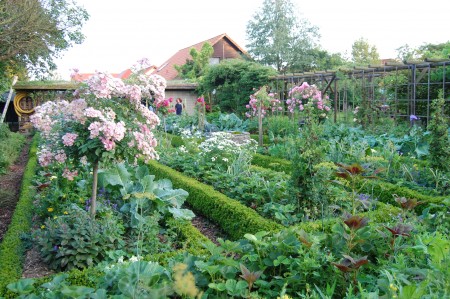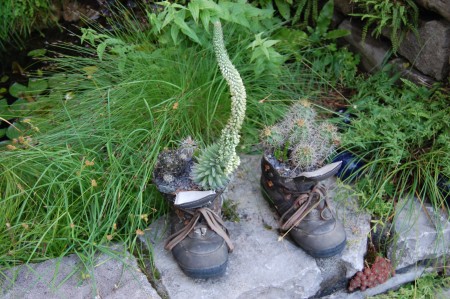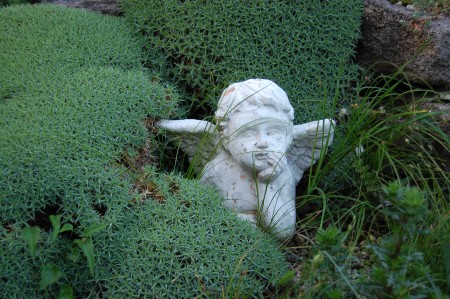
Rockeries are notoriously difficult to keep weed free in damp climates but in dry ones its amazing what can be done.
Its funny travelling around looking at other people’s gardens in different climate zones, as I so often end up wishing for something I haven’t got. A trip to Cornwall and I think how marvellous it would be to live somewhere where you could grow all those decadently juicy big rhododendrons , use brilliantly colourful Mexican Salvias in borders and be reasonably confident that they survive the winter, and dot the landscape with tree ferns. Such is the fantasy of many gardeners.
There are always downsides. Living in a relatively maritime climate myself, I rarely have to worry about water, or about it getting too cold or too hot, but there are real disadvantages to living somewhere where things just grow so well. Weeds. Unwanted weedy species grow huge and lush. As a result my gardening efforts are dominated by weed control, and to some extent also by curtailing all that lush growth – cutting back geraniums and astrantias before they have had too much of a chance to self-seed for example, or dealing with the vast mountains of debris at the end of the gardening year.
So, interesting a few weeks ago to visit Professor Wolfram Kircher in Saxony, in what was the old East Germany (aka. the GDR). Long cold winters, often quite hot, dry summers, and only 400mm of rain (we get 1500mm minimum). Wolfram and his wife Angela describe themselves as plant nerds. They have no idea how many thousand species inhabit their half acre garden. Everywhere you look there are micro-communities of plants. A rockery (partly composed of old kerbstones – the old communist ones weren’t good enough for the new look new Germany) bursts with plants, the paving on the drive seems to be being infiltrated by a miniature botanic garden, a strip of peat bog studded with orchids acts as a filter for a natural swimming pool (Prof. Kircher is a leading authority on this now very popular form of pool). We would have to be permanently on our hands and knees weeding this place, or arbitrating in disputes between rampantly spreading plants. In a dryish continental climate the weeds just don’t grow so well – in fact the Kirchers don’t describe weeds as a problem at all.
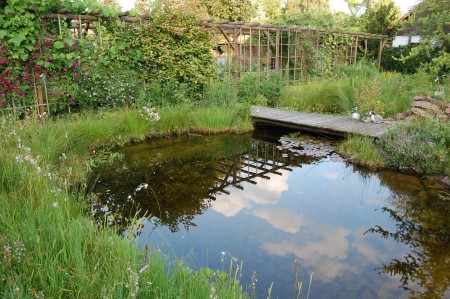
A natural swimming pool feels like the centrepiece of the garden. Water is cleaned by the action of plants and bacteria.
Part of the garden is a quite English looking area of box-bound raised beds with vegetables, fruit bushes and herbs; there are roses and a clematis-draped pergola. Self-sufficiency in fruit n’veg clearly no problem. But how are those raised beds built?…. poke around a bit…. hmmm, the ‘sides’ are actually the box hedges, so that on one side of the 40cms high hedges the soil (very loose and full of compost material)is actually supported by the box. We were astonished, at home the box would surely rot – maybe not, maybe we should give it a go?
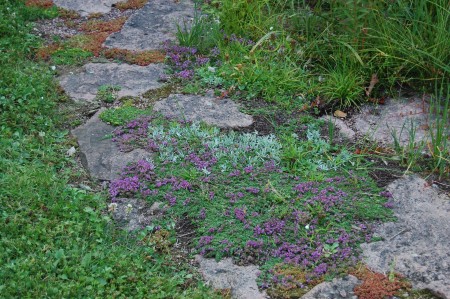
Gaps in paving can make a good habitat for low-level, don't mind being stepped on occasionally, plants, such as this thyme.
Being here reminded me a little of Lauren Spring and Scott Ogden’s garden in Colorado – similar ‘cold – dry’ continental climate I suppose. And yes, The Kirchers can grow cacti out of doors too, even through last winter’s minus 25C.
Would I live here, simply in order to grow more plants and not spend so much time weeding? Probably not, as I love our West Country lushness, but it is nice to know that if for some reason I ever got exiled to the bleak plains of the old GDR I could create a great garden.
************************+++++++++++++++++++************************
I am now publishing e-books through Amazon, for Kindle, smartphones, iPads etc. There are currently two of collections of writings for Hortus magazine from the early 2000s, plus a transcription of an hour long interview with Beth Chatto, one of the most influential gardeners of modern times. Click here to take a look.

